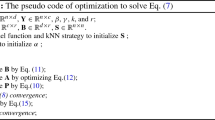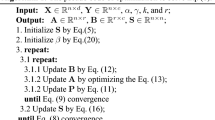Abstract
For existing unsupervised spectral feature selection algorithms, the quality of the eigenvectors decides the performance. There eigenvectors are calculated from the Laplacian matrix of similarity graph which is built from samples. When applying these algorithms to high-dimensional data, we meet the very embarrassing chicken-and-egg problem: “the success of feature selection depends on the quality of indication vectors which are related to the structure of data. But the purpose of feature selection is to give more accurate data structure.” To alleviate this problem, we propose a graph-based approach to reduce the dimension of data by searching and removing redundant features automatically. A sparse graph is generated at feature side and is used to learn the redundant relationship among features. We name this novel graph as sparse feature graph (SFG). To avoid the inaccurate distance information among high-dimensional vectors, the construction of SFG does not utilize the pairwise relationship among samples, which means the structure info of data is not used. Our proposed algorithm is also a nonparametric one as it does not make any assumption about the data distribution. We treat this proposed redundant feature removal algorithm as a data preprocessing approach for existing popular unsupervised spectral feature selection algorithms like multi-cluster feature selection (MCFS) which requires accurate cluster structure information based on samples. Our experimental results on benchmark datasets show that the proposed SFG and redundant feature remove algorithm can improve the performance of those unsupervised spectral feature selection algorithms consistently.










Similar content being viewed by others
References
Aggarwal, C.C., Hinneburg, A., Keim, D.A.: On the surprising behavior of distance metrics in high dimensional space. In: International Conference on Database Theory, pp. 420–434. Springer, Berlin (2001)
Beyer, K., Goldstein, J., Ramakrishnan, R., Shaft, U.: When is nearest neighbor meaningful? In: International Conference on Database Theory, pp. 217–235. Springer, Berlin (1999)
Cai, D., Zhang, C., He, X.: Unsupervised feature selection for multi-cluster data. In: Proceedings of the 16th ACM SIGKDD International Conference on Knowledge Discovery and Data Mining, pp. 333–342. ACM, New York (2010)
Dash, M., Liu, H.: Feature selection for classification. Intell. Data Anal. 1(3), 131–156 (1997)
Du, L., Shen, Y.D.: Unsupervised feature selection with adaptive structure learning. In: Proceedings of the 21th ACM SIGKDD International Conference on Knowledge Discovery and Data Mining, pp. 209–218. ACM, New York (2015)
Dy, J.G., Brodley, C.E.: Feature selection for unsupervised learning. J. Mach. Learn. Res. 5, 845–889 (2004)
Elhamifar, E., Vidal, R.: Sparse subspace clustering: algorithm, theory, and applications. IEEE Trans. Pattern Anal. Mach. Intell. 35(11), 2765–2781 (2013)
Han, S., Qin, H.: A greedy algorithm to construct sparse graph by using ranked dictionary. Int. J. Data Sci. Anal. 2(3), 131–143 (2016). https://doi.org/10.1007/s41060-016-0020-3
He, X., Ji, M., Zhang, C., Bao, H.: A variance minimization criterion to feature selection using Laplacian regularization. IEEE Trans. Pattern Anal. Mach. Intell. 33(10), 2013–2025 (2011)
Hou, C., Nie, F., Li, X., Yi, D., Wu, Y.: Joint embedding learning and sparse regression: a framework for unsupervised feature selection. IEEE Trans. Cybern. 44(6), 793–804 (2014)
Li, J., Cheng, K., Wang, S., Morstatter, F., Trevino, R.P., Tang, J., Liu, H.: Feature selection: a data perspective (2016). http://featureselection.asu.edu/
Koller, D.: Toward optimal feature selection. In: Proceeding of the 13th International Conference on Machine Learning, pp. 284–292. Morgan Kaufmann, Los Altos (1996)
Lee, V.E., Ruan, N., Jin, R., Aggarwal, C.: A survey of algorithms for dense subgraph discovery. In: Managing and Mining Graph Data, pp. 303–336. Springer, Berlin (2010)
Li, Z., Yi, Y., Liu, J., Zhou, X., Lu, H.: Unsupervised feature selection using nonnegative spectral analysis. In: AAAI (2012)
Liu, X., Wang, L., Zhang, J., Yin, J., Liu, H.: Global and local structure preservation for feature selection. IEEE Trans. Neural Netw. Learn. Syst. 25(6), 1083–1095 (2014)
Mairal, J., Yu, B.: Supervised feature selection in graphs with path coding penalties and network flows. J. Mach. Learn. Res. 14(1), 2449–2485 (2013)
Moujahid, A., Dornaika, F.: Feature selection for spatially enhanced lbp: application to face recognition. Int. J. Data Sci. Anal. 5(1), 11–18 (2018). https://doi.org/10.1007/s41060-017-0083-9
Ng, A.Y., Jordan, M.I., Weiss, Y., et al.: On spectral clustering: analysis and an algorithm. In: NIPS, vol. 14, pp. 849–856 (2001)
Peng, H., Long, F., Ding, C.: Feature selection based on mutual information criteria of max-dependency, max-relevance, and min-redundancy. IEEE Trans. Pattern Anal. Mach. Intell. 27(8), 1226–1238 (2005)
Robnik-Šikonja, M., Kononenko, I.: Theoretical and empirical analysis of relieff and rrelieff. Mach. Learn. 53(1–2), 23–69 (2003)
Song, Q., Ni, J., Wang, G.: A fast clustering-based feature subset selection algorithm for high-dimensional data. IEEE Trans. Knowl. Data Eng. 25(1), 1–14 (2013)
Sturm, B.L., Christensen, M.G.: Comparison of orthogonal matching pursuit implementations. In: 2012 Proceedings of the 20th European on Signal Processing Conference (EUSIPCO), pp. 220–224. IEEE (2012)
Tibshirani, R.: Regression shrinkage and selection via the lasso. J. R. Stat. Soc. Ser. B (Methodol.) 58, 267–288 (1996)
Tsourakakis, C., Bonchi, F., Gionis, A., Gullo, F., Tsiarli, M.: Denser than the densest subgraph: extracting optimal quasi-cliques with quality guarantees. In: Proceedings of the 19th ACM SIGKDD International Conference on Knowledge Discovery and Data Mining, pp. 104–112. ACM, New York (2013)
Wang, X., Mccallum, A., Wei, X.: Feature selection with integrated relevance and redundancy optimization. In: ICDM 2015. 15th IEEE International Conference on Data Mining, 2015, pp. 697–702. IEEE (2015)
Wang, D., Nie, F., Huang, H.: Feature selection via global redundancy minimization. IEEE Trans. Knowl. Data Eng. 27(10), 2743–2755 (2015)
Weber, R., Schek, H.J., Blott, S.: A quantitative analysis and performance study for similarity-search methods in high-dimensional spaces. In: VLDB, vol. 98, pp. 194–205 (1998)
Yang, Y., Shen, H.T., Ma, Z., Huang, Z., Zhou, X.: L2, 1-norm regularized discriminative feature selection for unsupervised learning. In: IJCAI Proceedings-International Joint Conference on Artificial Intelligence, vol. 22, p. 1589, Citeseer (2011)
You, C., Robinson, D.P., Vidal, R.: Scalable sparse subspace clustering by orthogonal matching pursuit. In: Proceedings of the IEEE Conference on Computer Vision and Pattern Recognition, pp. 3918–3927 (2016)
Yu, L., Liu, H.: Efficient feature selection via analysis of relevance and redundancy. J. Mach. Learn. Res. 5, 1205–1224 (2004)
Zhai, H., Haraguchi, M., Okubo, Y., Tomita, E.: A fast and complete algorithm for enumerating pseudo-cliques in large graphs. Int. J. Data Sci. Anal. 2(3), 145–158 (2016). https://doi.org/10.1007/s41060-016-0022-1
Zhao, Z., Wang, L., Liu, H.: Efficient spectral feature selection with minimum redundancy. In: AAAI (2010)
Zhao, Z., Wang, L., Liu, H., Ye, J.: On similarity preserving feature selection. IEEE Trans. Knowl. Data Eng. 25(3), 619–632 (2013)
Acknowledgements
This work is supported by NSF funding IIS-1715985.
Author information
Authors and Affiliations
Corresponding author
Additional information
Publisher's Note
Springer Nature remains neutral with regard to jurisdictional claims in published maps and institutional affiliations.
Rights and permissions
About this article
Cite this article
Xu, P., Han, S., Huang, H. et al. Redundant features removal for unsupervised spectral feature selection algorithms: an empirical study based on nonparametric sparse feature graph. Int J Data Sci Anal 8, 77–93 (2019). https://doi.org/10.1007/s41060-018-0167-1
Received:
Accepted:
Published:
Issue Date:
DOI: https://doi.org/10.1007/s41060-018-0167-1




